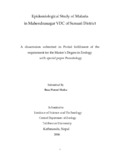Please use this identifier to cite or link to this item:
https://elibrary.tucl.edu.np/handle/123456789/1402Full metadata record
| DC Field | Value | Language |
|---|---|---|
| dc.contributor.author | Shahu, Ram Prasad | |
| dc.date.accessioned | 2018-04-27T07:06:32Z | |
| dc.date.accessioned | 2021-07-23T02:41:32Z | - |
| dc.date.available | 2018-04-27T07:06:32Z | |
| dc.date.available | 2021-07-23T02:41:32Z | - |
| dc.date.issued | 2006 | |
| dc.identifier.uri | http://elibrary.tucl.edu.np/handle/123456789/1402 | - |
| dc.description.abstract | The present study was conducted to assess the prevalence of malarial parasites among the people inhabiting the Mahendranagar VDC that lies in tropical region in Eastern Nepal. An active detection was made by collecting 250 blood samples from suspected individuals visiting at Health Post and Janasewa Clinic during the study period, by microscopic examination of thick and thin blood smear preparation. Besides this, structured questionnaire was used to assess the socio-economic status and the environmental aspects in relation to the malaria. Out of 250 blood samples collected, 10 samples were positive for the malaria infection. The slide positivity rate was found to be 4% and the causer organism was found to be Plasmodium vivax only. Age wise data revealed that of the total infected population the highest age specific slide positivity rate was found in 31-40 years age group (7.69%). Similarly in relation to sex, slide positivity rate was 5.33% in males and 2% in females. The prevalence rate of malaria was found to be higher in poor class people (5.15%) and those living in hut houses (7.54%). The malaria infection was common among Hindu people (4.65%) when compared to Muslim(0%) and Buddhist(0%).Likewise , prevalence of malaria was found to be the highest in illiterate (5.31%).Occupation wise prevalence was found to be highest in jobholders (5%) followed by farmer (4.8%) and labours (4.76%). High rate of infection was recorded during four summer months (April, May, July and September) with the largest number of patients during July (14.4%). In relation to environmental aspects and preventive measures malaria infection was common in hand pump users (4.13%) and in those applying no preventive measures (15%). With respect to migration, 80% (8 cases) of the total infected people were permanently inhabiting the area whereas 20% (2 cases) were migrated from India. Based on the present study; biological, physical and socio-economic measures are recommended to eradicate the malaria in the study area where there still needs to be conducted some integrated programmes for the eradication of malaria. | en_US |
| dc.language.iso | en_US | en_US |
| dc.publisher | Institute of Science and Technology Central Department of Zoology Tribhuvan University Kathmandu, Nepal | en_US |
| dc.subject | socio- economic | en_US |
| dc.subject | Environmental Responsibility | en_US |
| dc.subject | Malaria | en_US |
| dc.title | Epidemiological Study of Malaria in Mahendranagar VDC of Sunsari District | en_US |
| dc.type | Thesis | en_US |
| Appears in Collections: | Zoology | |
Items in DSpace are protected by copyright, with all rights reserved, unless otherwise indicated.

